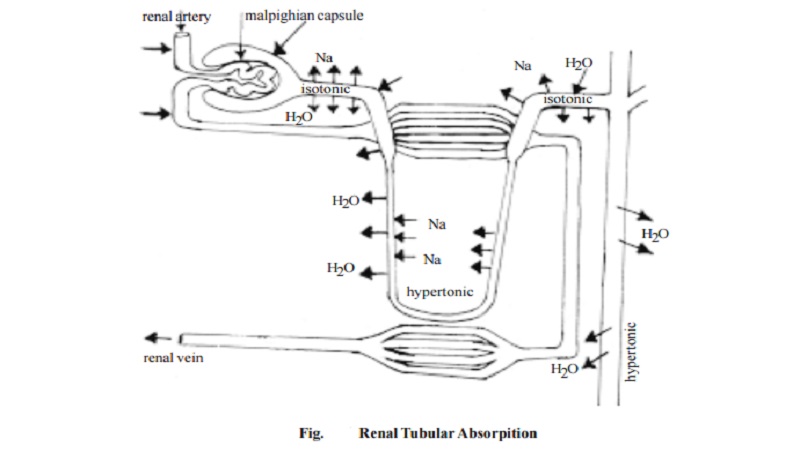Chapter: 11th 12th standard bio zoology Human Body higher secondary school
Mechanism of urine formation

Mechanism of urine formation
Urine is continually formed by each nephron and the processes involved in the formation of urine are
1. Glomerular ultra filtration,
2. Tubular Reabsorption,
3. Tubular Secretion
1. Glomerular ultra filtration

Ultrafiltration of blood takes place in the malpighian body which acts as a biological filter. A malpighian body comprises Bowmann's capsule and glomeruli.
Dynamics of filtration
The kidneys normally receive an abundant blood supply of about 1200ml/min or about 20 to 25 percent of the cardiac output. It flows through the capillaries of glomerulus where the blood pressure is comparatively high. The high blood pressure brings about effective filtration. The hydrostatic pressure (forward pressure 75mm/Hg.) of the blood in the afferent glomerular capillaries and the cumulative effect of the opposition pressures and renal intratubular pressure (10mm/Hg.) play an important role in producing the glomerular filtrate. The hydrostatic pressure of the blood is always greater than the opposing pressures existing in the plasma protein and renal capillaries. Thus the available net filtering force (75-50mm/Hg. = 25mm/Hg.) is chiefly responsible for glomerular filtration. The fluid in the capsule which is obtained by the process is termed glomerular filtrate. The volume of the glomerular filtrate produced each minute is called glomerular filtration rate (GFR). In man it is about 125ml/min. In 24 hours the total volume of glomerular filtrate is 170 to 180 liters.
2. Tubular Reabsorption
This is the second step in the urine formation. The glomerular filtrate contains many useful substances such as glucose, amino acids, mineral salts and vitamins dissolved in large amount of water. Reabsorption takes place in the uriniferous tubules. Reabsorption of useful substances is a differential or selective process. Substances such as glucose, sodium and calcium, are called 'high threshold substance' . They are actively reabsorbed in considerable quantities. Substances like urea and uric acid etc which are called 'low threshold substances' are reabsorbed in small quantities by a simple diffusion process or passive reabsorption. Substances like creatinine are not reabsorbed. They are completely eliminated.
Reabsorption in Proximal Convoluted Tubule
Proximal convoluted tubule is responsible for the reabsorption of water, glucose, sodium phosphate and bicarbonates. The urine is found to be isotonic in the proximal convoluted tubule. Isotonic condition of a solution indicates no passage of water across the membrane separating two such solutes.
Reabsorption in Henle's loop
Urine becomes more and more hypertonic as it passes through the descending limb of the loop of Henle's. This is due to the fact that the thin descending portions of the Henles loop are freely permeable to sodium. As the urine slowly passes through the thick ascending limb of the loop of Henle, it becomes less hypertonic since the sodium is actively transported from the ascending limb to the descending limb through the interstitial tissue space.
Reabsorption in distal convoluted tubule
On entering the distal convoluted tubule, the urine becomes nearly isotonic to the surrounding tissue fluid due to the active transport of sodium and passive transport of water. Summary of Renal Filtration and Reabsorption in 24 hours
Reabsorption in collection tubule
As urine (isotonic) passes into the collecting tubule it becomes once more hypertonic by the osmotic reabsorption of water under the influence of the hormone ADH. The release of ADH is controlled by the osmoreceptors in the hypothalamus in response to changes in the osmotic pressure of the plasma circulating through the collecting tubule. Thus the urine formed contains 96% of water, 2% urea and 2% of the metabolic products.
A comparison of the amounts of various substances in 24 hrs in the glomerular filtrate and excretion
Substance Amount filtered Amount excreted in
each day Urine each day
Water 180 ltrs 1-2 ltrs
Protein 2g 0.1g
Sodium 580g 5g
Chloride 640g 6g
Potassium 30g 2g
Bicarbonate 275g 0
Glucose 180g 0
Urea 53g 25g
Uric acid 8.5g 1g
Creatinine 1.6g 1.6g
Tubular Secretion
This is the final step in the formation of urine during which the walls of tubule actively remove additional waste substances which are harmful to the body from the blood that have escaped filtration.
Related Topics